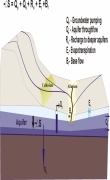/topics/rainfall-and-other-forms-precipitation
Rainfall and other forms of Precipitation
Rural development - Mid-term appraisal of the eleventh five year plan - Report by the Planning Commission
Posted on 22 Sep, 2010 06:16 PMThe Eleventh Plan (2007-08 to 2011-12) sought to build on the gains achieved in the Tenth Plan and shift the economy to a path of faster and more inclusive growth. The Mid Term Appraisal (MTA) report for the Eleventh Five Year Plan 2007-2012 by the Planning Commission reviews the experience in the first three years of the Plan and seeks to identify areas where corrective steps may be needed.
India’s groundwater typologies – A presentation by ACWADAM
Posted on 22 Sep, 2010 08:01 AMThis presentation by ACWADAM deals with groundwater typologies in India. The typology of groundwater can be defined in many ways based on a) Uses of Groundwater, b) Geography, c) Geology, d) Hydrogeology (Aquifers), e) Groundwater Quality, f) Stage of Groundwater Development, and g) Socio-ecology of Groundwater.
Groundwater balance – A presentation by ACWADAM
Posted on 21 Sep, 2010 10:00 PM This presentation by ACWADAM deals with the subject of groundwater balance. It begins by describing the skeleton for the water balance equation viz., ground surface, soil, aquifer and bed rock. It describes the processes subsequent to rainfall such as interception, initial detention, depression storage, infiltration, runoff, streamflow, soil moisture retention and recharge.
This presentation by ACWADAM deals with the subject of groundwater balance. It begins by describing the skeleton for the water balance equation viz., ground surface, soil, aquifer and bed rock. It describes the processes subsequent to rainfall such as interception, initial detention, depression storage, infiltration, runoff, streamflow, soil moisture retention and recharge.
The watershed water balance equation is explained in terms of input (rainfall and water transfers) and output (runoff, evapotranspiration and infiltration). It notes that the input to a generalized water balance is rainfall whereas the input to a groundwater balance is infiltration. The difference between infiltration & recharge, natural & artificial recharge and interflow & discharge are explained thereafter. The water balance for an aquifer may vary, depending upon the nature of groundwater system –
- Watershed with a deep aquifer
- Watershed has both shallow and deep aquifers
- Watershed has only shallow aquifer
Floods, Rains - News Roundup (8-15 September 2010)
Posted on 16 Sep, 2010 04:10 PMFloods, rains, droughts
There have been reports of flooding as well as incessant rains in the northern parts of India such as Delhi, Punjab, Haryana, Chandigarh, Uttar Pradesh, Rajasthan as well as the northeast such as Assam, Arunachal Pradesh. At the same time, reports indicate that parts of Madhya Pradesh have been facing severe drought while parts of Himachal Pradesh indicate sudden drops in temperature with reports of snowfall in certain areas. Reports from West Bengal also indicate extensive flooding in certain parts of the state.
"Dams on the Himalayas: Environmentalists demand scrapping of projects in Assam, Manipur and Arunachal Pradesh" :News roundup (8-15 September 2010)
Posted on 16 Sep, 2010 04:07 PMWaterbodies/ Rivers
"The Vision of Natural Farming" - Book by Bharat Mansata, 2010
Posted on 15 Sep, 2010 03:31 PM
“It is only by mixed organic farming in harmony with Nature that India can sustainably provide abundant wholesome food, and meet every basic need of all – to live in health, dignity and peace.” Bhaskar Save
Floods - News Roundup - September 1-7 2010
Posted on 14 Sep, 2010 02:07 AMAndhra Pradesh
- Flood water submerges 10 villages under Subbareddy Sagar, Kakinada
- Floods wreak havoc on crops in AP
- Officials heave sigh of relief as water recedes
- Incessant rains ruin rural roads
- Rains claim three lives in EG
- Floodwater inflow fluctuates
- Water let off from Nagarjunasagar dam
- Downpour washes away farmers' hopes in AP
Unusually intense monsoon rains in many parts of Asia - Article from Earth Observatory
Posted on 13 Sep, 2010 11:20 PM

The first week of August 2010 brought extreme flooding and landslides to many parts of Asia. By August 11, floods in the Indus River basin had become Pakistan’s worst natural disaster to date, leaving more than 1,600 people dead and disrupting the lives of about 14 million people, reported Reuters. Across the border in northeast India, flash floods killed 185 with 400 still missing, reported BBC News. Floods in North Korea and northeast China buried farmland and destroyed homes, factories, railroads, and bridges. And in northwest China, rain triggered a massive landslide that left 702 dead with 1,042 missing, reported China’s state news agency, Xinhua. All of these disasters occurred as a result of unusually heavy monsoon rains, as depicted in the above image.
Why study weather – A presentation by ACWADAM
Posted on 12 Sep, 2010 11:03 AMThis presentation by ACWADAM deals with weather, the most fundamental process that shapes the earth. Meteorology, the science of studying weather, is described where some predictions can be made using atmospheric conditions or some data can be generated using simple equipments. These can in turn be used for measurement of weather for better implementation of a watershed project.
Measurement of weather parameters: Data collection and analysis – A presentation by ACWADAM
Posted on 24 Aug, 2010 09:29 PMThe presentation by ACWADAM deals with measurement of weather parameters and outlines the methods used in weather related data collection and analysis. Weather information is necessary for the planning and implementation of watershed programmes, especially in understanding factors like groundwater recharge, the relationship between recharge & discharge and in aspects like irrigation planning.





